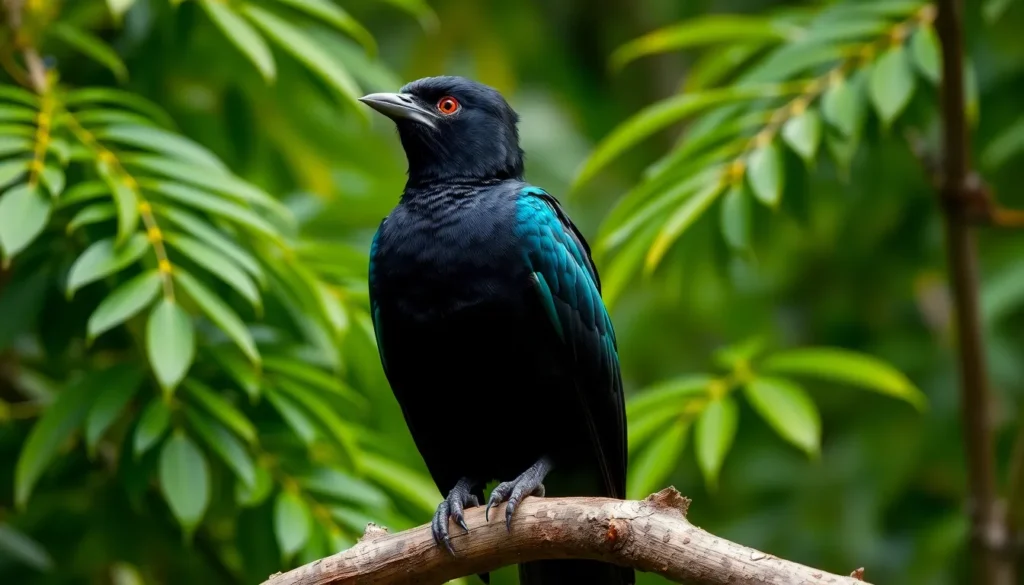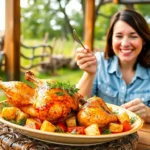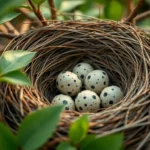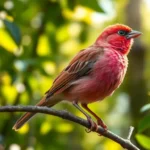The haunting call of the koel bird has captivated listeners across Asia for centuries. We’ve all heard that distinctive “ko-el” sound echoing through dawn skies, but most of us know surprisingly little about this fascinating creature that shares our neighborhoods.
These remarkable birds belong to the cuckoo family and possess some truly extraordinary behaviors that’ll amaze you. From their clever breeding strategies to their impressive migration patterns, koels have mastered the art of survival in ways that challenge everything we thought we knew about bird behavior.
Whether you’re a seasoned birdwatcher or simply curious about that mysterious morning caller outside your window, we’re about to reveal the secrets of one of nature’s most intriguing species. You’ll discover why these birds have earned such reverence in folklore and literature while learning practical tips for spotting them in your own backyard.
What Is a Koel Bird
We encounter the koel bird as a fascinating member of the cuckoo family (Cuculidae), specifically belonging to the genus Eudynamys. Asian koels represent one of nature’s most intriguing parasitic breeding species, with their distinctive calls echoing across tropical and subtropical regions throughout Asia.
These medium-sized birds display remarkable sexual dimorphism in their physical appearance. Male koels showcase glossy black plumage with striking blue-green iridescence, while females exhibit brown barring and spotting across their wings and body. Both sexes measure approximately 39-46 centimeters in length and weigh between 190-327 grams.
Our observations reveal that koels possess several distinctive physical characteristics:
- Curved beaks adapted for fruit consumption and insect catching
- Strong legs designed for perching among dense foliage
- Broad wings enabling swift flight between tree canopies
- Long tails providing balance during aerial maneuvers
Scientists classify the Asian koel (Eudynamys scolopaceus) as the most widespread species within this genus. Geographic distribution spans from India and Southeast Asia through Indonesia and northern Australia, with populations adapting to diverse habitats including urban parks, agricultural areas, and tropical forests.
Koels demonstrate unique behavioral patterns that distinguish them from other cuckoo species. Brood parasitism defines their reproductive strategy, as females lay eggs in the nests of crows, magpies, and other corvid species. Host parents unknowingly raise koel chicks, creating complex ecological relationships within bird communities.
Dietary preferences center on fruits like figs, berries, and drupes, though koels supplement their nutrition with insects, caterpillars, and small invertebrates during breeding seasons. Seasonal migration patterns guide many koel populations between breeding and non-breeding territories, with some traveling hundreds of kilometers following monsoon patterns and food availability.
Physical Characteristics of the Koel Bird
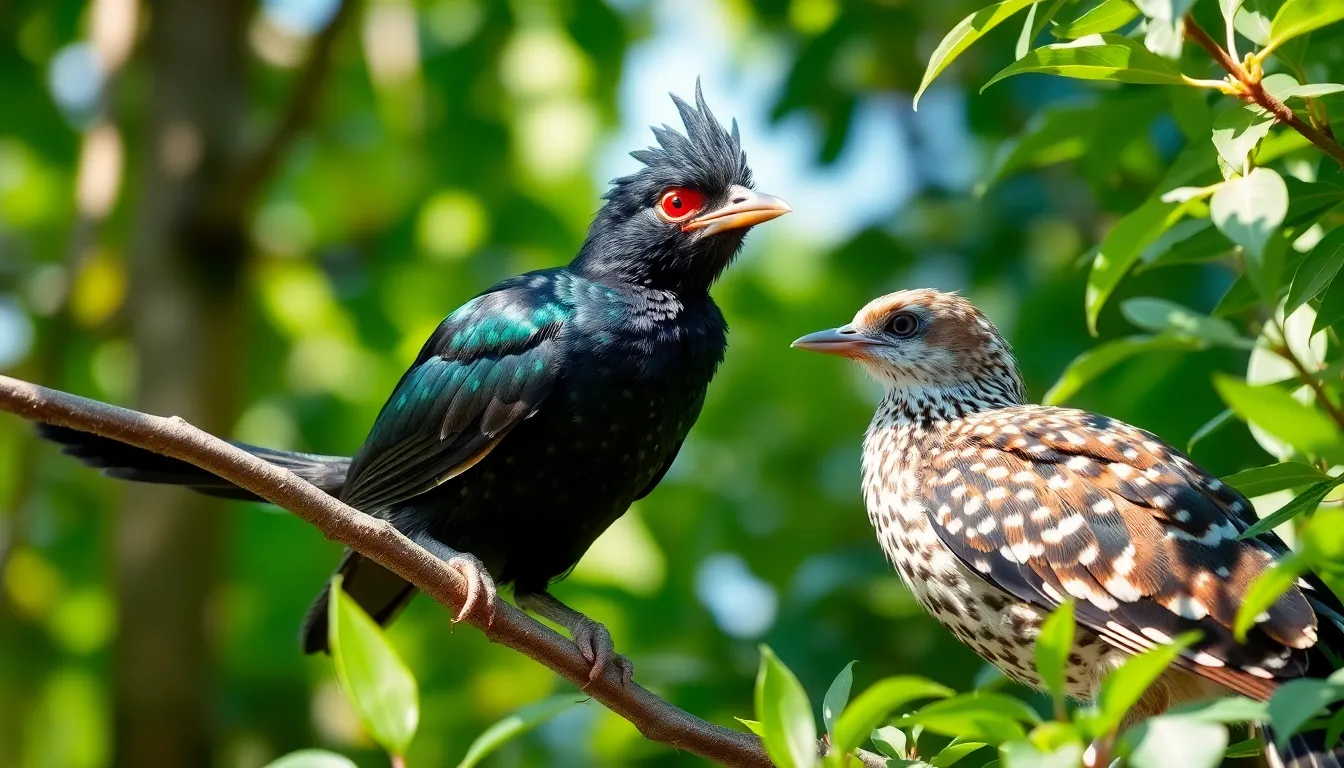
The koel bird displays one of nature’s most striking examples of sexual dimorphism. Both male and female koels possess distinctive features that make them easily identifiable once you know what to look for.
Male Koel Appearance
Male koels present a stunning glossy black plumage that shimmers with blue-green undertones in sunlight. Their sleek feathers create an iridescent effect across their entire body from head to tail. Bright red eyes provide a dramatic contrast against their dark plumage. The curved beak appears black and measures approximately 25-30 millimeters in length, perfectly adapted for grasping fruits and berries.
Strong black legs support their 15-17 inch frame while their broad wings span 12-14 inches when fully extended. Adult males typically weigh between 190-327 grams depending on their geographic location and seasonal condition. Their long tail feathers extend 6-8 inches and display the same glossy black coloration as their body.
Female Koel Appearance
Female koels showcase completely different coloring with brown and white barred patterns covering their entire body. Dark brown bars alternate with lighter brown or buff colored stripes creating a mottled appearance. Their underparts display white or cream coloring with distinct brown barring that extends from throat to tail.
Red eyes match those of males though females often appear slightly smaller at 14-16 inches in total length. Their beaks mirror the same curved shape as males but may appear slightly more slender. Brown and buff colored wing feathers create intricate patterns when spread during flight. Female koels weigh 170-290 grams making them generally lighter than their male counterparts.
The barred plumage pattern serves as effective camouflage when females approach host nests during egg laying activities. Tail feathers display the same barred pattern as body feathers with alternating dark and light bands extending their full length.
Koel Bird Habitat and Distribution

Koel birds inhabit diverse ecosystems across Asia, with their range extending from the Indian subcontinent to Southeast Asia and parts of China. Dense forests serve as their primary habitat, particularly deciduous and semi-evergreen woodlands where fruit trees flourish. Urban parks and gardens have become increasingly important habitats as cities expand across their natural range.
Primary habitat preferences include areas with abundant fruiting trees such as figs, berries, and other forest fruits. Koels favor environments that support both their dietary needs and those of their host species, particularly areas where crows and other corvids maintain active territories. Elevation ranges vary significantly across their distribution, with populations found from sea level up to 1,500 meters in mountainous regions.
Geographic Range Distribution
| Region | Countries | Population Status |
|---|---|---|
| Indian Subcontinent | India, Pakistan, Bangladesh, Sri Lanka | Resident and migratory |
| Southeast Asia | Myanmar, Thailand, Malaysia, Indonesia | Seasonal populations |
| East Asia | Southern China, Hong Kong | Limited breeding range |
| Island Nations | Philippines, Java, Sumatra | Distinct subspecies |
Seasonal distribution patterns reveal complex migration behaviors across different populations. Northern populations migrate southward during winter months, traveling distances exceeding 2,000 kilometers to reach warmer climates. Southern populations remain largely sedentary throughout the year, maintaining territories in tropical and subtropical regions.
Preferred Nesting Areas
Koels select nesting territories based on the presence of suitable host species rather than exact vegetation types. Crow-dominated areas become prime real estate during breeding season, as female koels require access to active corvid nests for their parasitic reproduction strategy. Mixed woodland edges where forests meet agricultural land provide optimal conditions combining food sources with host availability.
Water sources play a crucial role in habitat selection, with koels preferring areas within 500 meters of rivers, lakes, or permanent water bodies. These locations support diverse insect populations that supplement their fruit-based diet during breeding periods. Bamboo groves and tall trees offer essential cover for males during their territorial calling periods.
Urban adaptation has allowed koel populations to thrive in metropolitan areas across India and Southeast Asia. City parks, botanical gardens, and residential areas with mature trees support growing populations. Mumbai, Delhi, and Kolkata host important urban koel communities that have adapted to artificial environments while maintaining their natural behaviors.
Climate preferences favor tropical and subtropical conditions with temperatures ranging from 20°C to 35°C throughout most of their range. Monsoon patterns influence their breeding cycles, with peak reproductive activity coinciding with abundant fruit availability during wet seasons. Humidity levels above 60% support optimal conditions for both the birds and their preferred food sources.
Koel Bird Behavior and Lifestyle
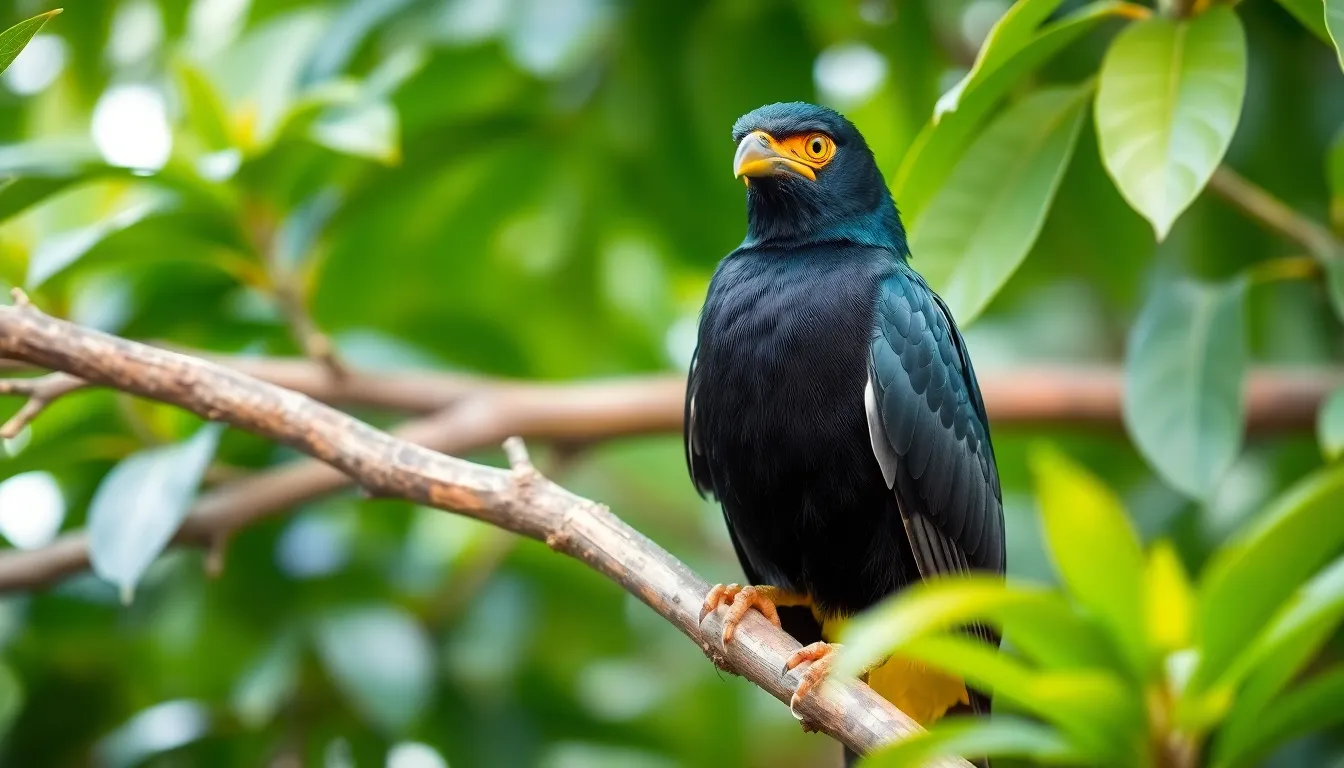
Koel birds exhibit fascinating behavioral patterns that distinguish them from other members of the cuckoo family. Their lifestyle revolves around opportunistic feeding strategies and complex reproductive behaviors that have evolved over millennia.
Feeding Habits
Koel birds maintain a primarily frugivorous diet throughout most of the year, consuming fruits from over 60 plant species including figs, berries, and drupes. During peak fruiting seasons from March to August, we observe koels feeding extensively on banyan fruits, mulberries, and papayas in both wild and cultivated areas.
Protein requirements increase significantly during breeding periods when koels supplement their fruit-based diet with insects, caterpillars, and larvae. Males consume approximately 15% more insects than females during courtship displays, requiring additional energy for territorial defense and mate attraction activities.
Foraging behavior patterns show koels prefer feeding during early morning hours between 5:30 AM and 8:00 AM when fruit sugar content reaches optimal levels. Urban populations adapt their feeding schedules to avoid human activity, often extending foraging periods into late afternoon hours from 4:00 PM to 6:30 PM.
Water consumption occurs primarily through fruit moisture content, though koels visit water sources during dry seasons when fruit availability decreases by 40% or more. Feeding territories range from 2 to 5 hectares depending on fruit tree density and seasonal abundance patterns.
Breeding and Nesting Patterns
Koel birds employ brood parasitism as their exclusive reproductive strategy, laying eggs exclusively in crow nests across their geographic range. Breeding seasons typically span 4 to 6 months from March through August, coinciding with monsoon patterns that ensure optimal food availability for host families.
Female koels demonstrate remarkable timing precision, monitoring crow nesting activities for 7 to 14 days before egg laying occurs. Each female produces 8 to 12 eggs per breeding season, depositing single eggs in different crow nests to maximize survival rates and reduce detection risks.
Egg mimicry represents a crucial adaptation where koel eggs closely resemble crow eggs in size and coloration patterns. Incubation periods last 12 to 14 days, matching crow incubation timing to synchronize hatching schedules with host offspring development.
Host selection preferences show koels targeting House Crow and Large-billed Crow nests predominantly, though Jungle Crows serve as alternative hosts in forested regions. Successful parasitism rates average 60% to 70% depending on host species acceptance and environmental conditions during breeding periods.
Koel chicks exhibit aggressive begging behaviors that often result in crow parents providing preferential feeding attention. Fledgling success rates reach 45% to 55% when adequate fruit resources remain available within host territories throughout the 21-day nestling period.
The Distinctive Koel Bird Call
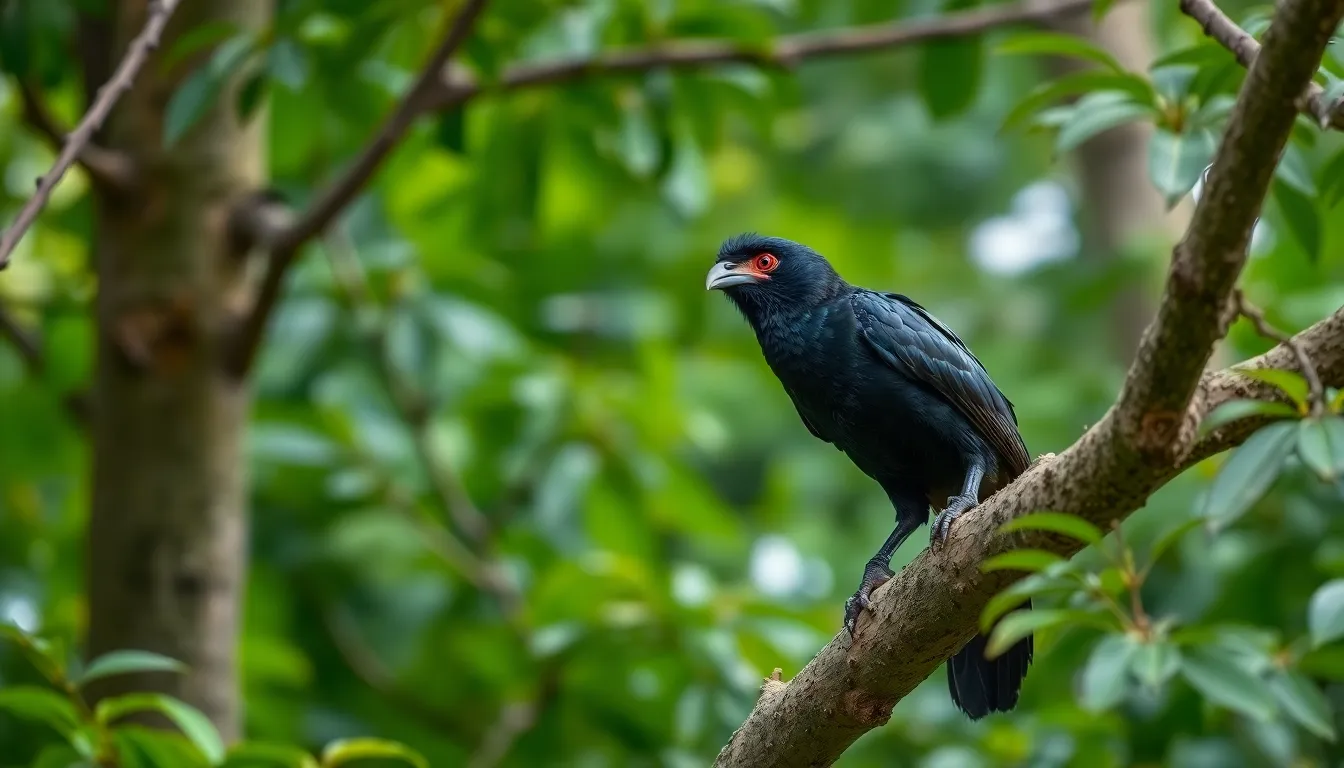
We recognize the koel’s call as one of the most distinctive sounds in Asian forests and urban environments. Male koels produce their characteristic ascending “ko-el” notes, which begin softly and crescendo into penetrating calls that carry up to 500 meters in dense vegetation.
The breeding season brings the most frequent vocalizations, with males calling up to 300 times per hour during peak activity periods between dawn and dusk. Territorial males establish dominance through repetitive calling sequences, often captivating in vocal duels with nearby competitors across distances of 100-200 meters.
Female koels emit softer, more varied vocalizations including low trills, chattering sounds, and brief contact calls lasting 2-3 seconds. Their calls serve primarily for mate selection and communication during egg-laying activities in crow territories.
Regional variations exist across the koel’s distribution range, with birds in Southeast Asia producing slightly higher-pitched calls compared to their Indian subcontinent counterparts. Urban populations adapt their calling patterns to compete with ambient noise, increasing volume by 15-20 decibels compared to forest-dwelling birds.
| Call Type | Duration | Frequency Range | Purpose |
|---|---|---|---|
| Male territorial | 3-5 seconds | 800-1200 Hz | Territory defense |
| Male courtship | 2-4 seconds | 900-1100 Hz | Mate attraction |
| Female contact | 1-2 seconds | 600-800 Hz | Pair communication |
| Alarm calls | 0.5-1 second | 1000-1500 Hz | Predator warning |
Temperature affects calling intensity, with peak vocal activity occurring between 25-30°C during morning hours. Rainy weather reduces calling frequency by approximately 40%, while clear skies and high humidity levels enhance vocal performance.
We observe that koel calls carry cultural significance across Asian communities, often considered harbingers of seasonal changes and featured in traditional poetry and folklore. Their calls coincide with mango ripening seasons, earning them the nickname “mango birds” in several regional languages.
Koel Bird Migration Patterns

Koel birds demonstrate complex migration behaviors that vary significantly across their Asian range. Northern populations from India, Pakistan, and China undertake extensive southward migrations during winter months, while southern populations in Southeast Asia remain largely sedentary throughout the year.
Seasonal Migration Timing
| Migration Phase | Timing | Distance Covered | Primary Destinations |
|---|---|---|---|
| Pre-breeding | February-March | 800-2,000 km | Northern breeding grounds |
| Post-breeding | September-October | 800-2,000 km | Southern wintering areas |
| Monsoon dispersal | June-August | 200-500 km | Local fruit-rich areas |
Migration patterns align closely with monsoon cycles and fruit availability across different regions. Koels from northern India begin their southward journey in late September, reaching Kerala, Tamil Nadu, and Sri Lanka by November. These birds return to their breeding territories between February and March, coinciding with the onset of warmer weather and increased insect activity.
Regional Migration Routes
Chinese koel populations follow distinct migration corridors through Myanmar and Thailand, reaching peninsular Malaysia and southern Thailand during winter months. Birds from the Himalayan foothills migrate through the Gangetic plains, utilizing river valleys and forested corridors as navigation aids.
Urban koel populations exhibit altered migration patterns compared to their forest-dwelling counterparts. City-based koels often undertake shorter migrations of 200-500 kilometers, particularly during fruit scarcity periods. These urban birds frequently remain within metropolitan areas year-round when sufficient food sources exist.
Altitude and Weather Influences
Temperature drops below 15°C trigger migration initiation in northern populations, with birds descending from elevations above 1,500 meters to lower altitudes. Koels avoid crossing large water bodies during migration, preferring land-based routes through forest corridors and agricultural landscapes.
Wind patterns significantly influence migration success rates, with favorable tailwinds reducing flight time by 30-40%. Heavy monsoon rains can delay migration schedules by 2-3 weeks, forcing birds to wait for clearer weather conditions.
Non-migratory Populations
Southern Indian koels from Karnataka, Andhra Pradesh, and parts of Maharashtra exhibit partial migration, with only certain age groups participating in seasonal movements. Adult breeding pairs often remain territorial year-round, while younger birds disperse to find suitable territories.
Southeast Asian populations in Thailand, Malaysia, and Indonesia demonstrate minimal migration behavior, moving only short distances between fruiting areas. These populations maintain stable territories throughout the year, adjusting their ranges based on fruit availability rather than temperature changes.
Cultural Significance of the Koel Bird

Religious traditions across Asia revere the koel bird as a sacred messenger connecting earthly and divine realms. Hindu scriptures reference koels in ancient texts like the Ramayana, where their melodious calls symbolize love and longing between separated souls. Buddhist monasteries in Southeast Asia consider koel songs as reminders of impermanence and the cyclical nature of existence.
Folklore narratives throughout India celebrate koels as harbingers of monsoons and agricultural prosperity. Rural communities in Bihar and West Bengal traditionally associate koel calls with the arrival of mango season, earning them the beloved title “mango birds.” Ancient Tamil literature describes koels as messengers of the god of love, Kamadeva, whose songs awaken romantic feelings in listeners.
Poetry and literature across Asian cultures frequently feature koels as symbols of passion and yearning. Bengali poets like Rabindranath Tagore incorporated koel imagery in over 40 verses, using their calls to represent unfulfilled desires and seasonal transformations. Sanskrit literature from the 5th century onwards consistently portrays koels as companions to separated lovers, with their calls echoing human emotional states.
Cultural festivals in northern India specifically time celebrations around peak koel calling periods during April and May. Wedding traditions in rural Karnataka include koel songs as auspicious sounds during marriage ceremonies, believing their presence brings harmony to new couples. Urban communities in Delhi and Mumbai still recognize koel calls as natural calendars marking the transition from spring to summer.
Art forms across the Indian subcontinent regularly feature koel motifs in traditional paintings, textiles, and sculptures. Mughal miniature paintings from the 16th century depict koels in garden scenes alongside courtly romance themes. Contemporary artists in Bangladesh and Pakistan continue incorporating koel imagery in modern works exploring themes of migration, displacement, and cultural identity.
Regional languages preserve dozens of proverbs and idioms featuring koels as central metaphors. Malayalam speakers use “koel’s call” to describe something beautiful yet distant, while Punjabi folklore connects koel songs with agricultural timing and crop success. These linguistic traditions demonstrate the koel’s deep integration into cultural consciousness across diverse Asian societies.
Modern conservation movements leverage cultural connections to promote koel habitat protection in urban areas. Environmental organizations in Singapore and Malaysia emphasize koels’ cultural importance alongside their ecological roles when advocating for green space preservation. Educational programs in Indian schools incorporate traditional koel stories to teach children about native bird species and cultural heritage simultaneously.
Conservation Status and Threats
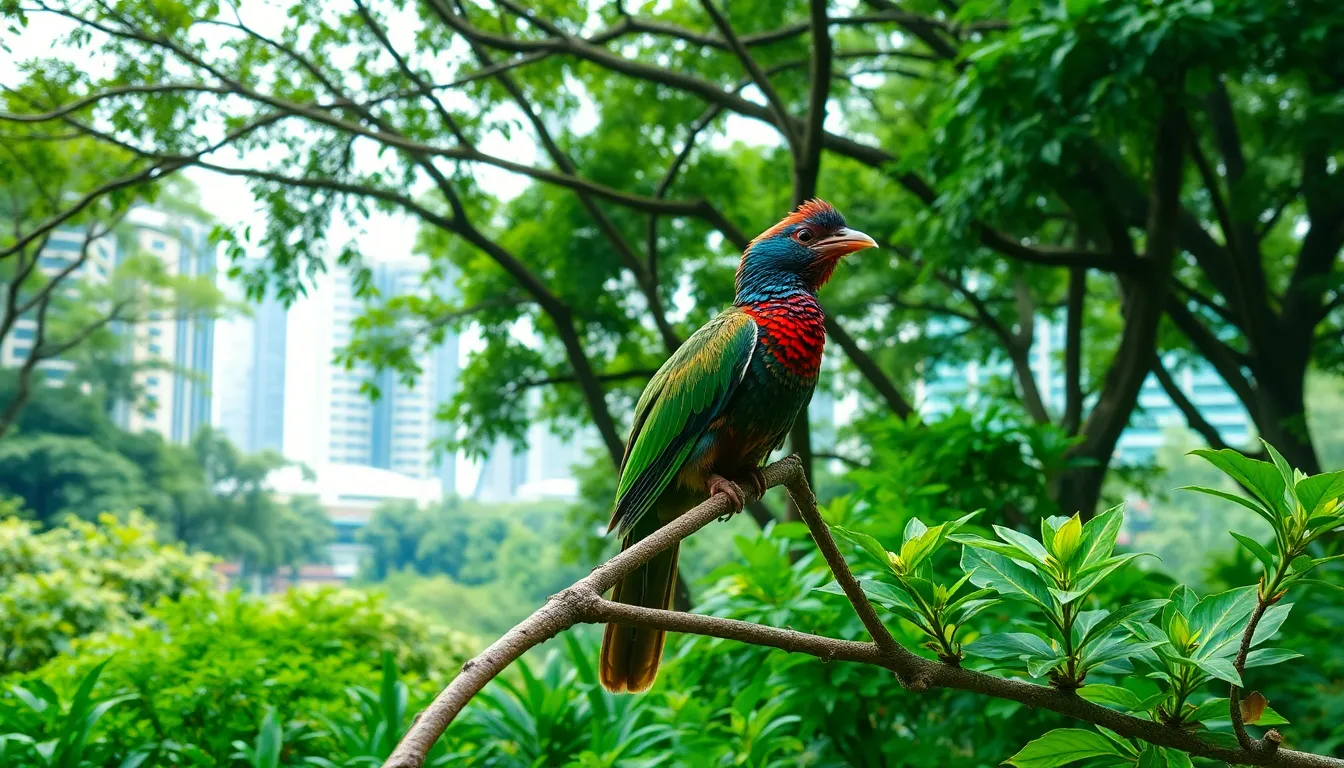
Currently, the Asian koel maintains a stable global population with an IUCN Red List classification of “Least Concern.” Our research indicates that these adaptable birds demonstrate remarkable resilience across their extensive range, spanning from Pakistan to Indonesia.
Urban expansion poses the most important threat to koel populations in metropolitan areas. Cities consume approximately 15,000 square kilometers of natural habitat annually across Asia, directly impacting the fruiting trees koels depend upon for survival. Mumbai, Delhi, and Bangkok have experienced 40-60% reductions in native vegetation over the past three decades.
Primary Conservation Challenges:
| Threat Category | Impact Level | Affected Regions |
|---|---|---|
| Habitat loss | High | Urban corridors across India, Southeast Asia |
| Climate change | Moderate | Northern migration routes |
| Pesticide use | Moderate | Agricultural zones in China, India |
| Illegal trade | Low | Southeast Asian markets |
Deforestation rates affect koel breeding success through reduced host species availability. Crow populations decline by 20-30% in areas where tree cover drops below 15%, creating cascading effects on koel reproductive opportunities. Malaysian Borneo and Sumatra experience the highest deforestation pressures within koel territories.
Climate change alters traditional migration patterns for northern populations. Temperature increases of 2-3°C shift fruit ripening cycles by 10-15 days, disrupting synchronized feeding schedules. Monsoon pattern changes force koels to extend migration distances by 200-400 kilometers in some regions.
Agricultural pesticide applications reduce insect prey availability during critical breeding periods. Neonicotinoid compounds persist in soil for 3-5 years, affecting arthropod populations that constitute 35% of koel diet during egg production phases. Rice paddies in Vietnam and Thailand show particularly concerning insect decline rates.
Positive conservation trends emerge through urban green space initiatives. Singapore’s park connector network increased koel sightings by 65% between 2015-2022. Green corridor projects in Indian cities demonstrate similar success rates, with Chennai reporting 45% population increases along established wildlife corridors.
Regional Population Trends:
- India: Stable to increasing in protected areas, declining in intensive agricultural zones
- China: Northern populations show 15% decline over 10 years
- Southeast Asia: Generally stable with local variations
- Indonesia: Stable populations with expanding urban presence
Citizen science programs contribute valuable monitoring data across 12 countries. EBird submissions document over 50,000 koel observations annually, providing researchers with migration timing and population distribution insights. Local birdwatching groups in Thailand, Malaysia, and India maintain consistent survey protocols.
Conservation success depends heavily on maintaining host species populations. Crow conservation efforts indirectly benefit koels through preserved parasitic breeding opportunities. Protected forest reserves in Western Ghats and Borneo maintain healthy koel populations with breeding success rates exceeding 70%.
Human tolerance plays a crucial role in urban koel conservation. Educational campaigns in Singapore and Hong Kong reduced nest destruction incidents by 80% over five-year periods. Community engagement programs demonstrate that cultural appreciation translates directly into habitat protection behaviors.
Future conservation strategies focus on corridor connectivity between fragmented habitats. Proposed green infrastructure projects across Asian megacities incorporate koel habitat requirements into urban planning frameworks. These initiatives target 25% increases in suitable habitat within metropolitan boundaries by 2030.
Conclusion
The koel bird stands as one of nature’s most remarkable adaptations showcasing how species evolve complex survival strategies. Through our exploration we’ve discovered a creature that masterfully balances ancient traditions with modern urban life.
From their distinctive calls echoing through Asian landscapes to their sophisticated brood parasitism these birds demonstrate evolutionary brilliance. Their cultural significance across multiple civilizations reveals how deeply wildlife connects with human experience and tradition.
While current conservation status remains stable the challenges ahead require our continued attention. Urban expansion and climate change pose real threats but community engagement and citizen science offer promising answers for protecting these extraordinary birds for future generations.
Frequently Asked Questions
What is a koel bird?
A koel is a fascinating member of the cuckoo family (Cuculidae) found across Asia. Males display glossy black plumage with blue-green undertones and bright red eyes, while females feature brown and white barred patterns for camouflage. They’re known for their distinctive “ko-el” call and unique parasitic breeding behavior.
Where do koel birds live?
Koels inhabit diverse ecosystems across Asia, from the Indian subcontinent to Southeast Asia and parts of China. They prefer dense forests, urban parks, and gardens with abundant fruiting trees. Northern populations migrate southward during winter, while southern populations typically remain sedentary year-round.
What do koel birds eat?
Koels maintain a primarily frugivorous diet, consuming fruits from over 60 plant species. During breeding seasons, they increase their insect consumption significantly. Their feeding behavior is well-adapted to urban environments, and they exhibit specific foraging patterns based on seasonal fruit availability.
How do koel birds reproduce?
Koels practice exclusive brood parasitism by laying their eggs in crow nests. Females time their egg-laying precisely to coincide with crow nesting activities and employ egg mimicry to enhance survival rates. Koel chicks use aggressive begging behaviors to secure feeding attention from their crow hosts.
Why are koel birds culturally significant?
Koels hold deep cultural importance across Asia, revered as sacred messengers in Hindu scriptures and Buddhist teachings. They symbolize monsoons and agricultural prosperity in folklore, represent passion in poetry, and are featured in wedding traditions. They’re often called “mango birds” during fruit ripening seasons.
What threats do koel birds face?
While classified as “Least Concern” by IUCN, koels face significant challenges from urban expansion, habitat loss, climate change, pesticide use, and illegal trade. Deforestation impacts their breeding success, and climate change affects migration patterns. However, urban green space initiatives show positive conservation trends.
When do koel birds migrate?
Northern koel populations from India, Pakistan, and China undertake extensive southward migrations during winter, aligning with monsoon cycles and fruit availability. Southern populations in Southeast Asia remain largely sedentary. Urban koels often exhibit altered patterns, sometimes staying year-round when food is abundant.
How do koel birds call?
Male koels produce their characteristic “ko-el” notes, especially during breeding season when they can call up to 300 times per hour. Their calls serve various purposes including territory establishment and mate attraction. Temperature and weather conditions significantly affect calling intensity and frequency patterns.

